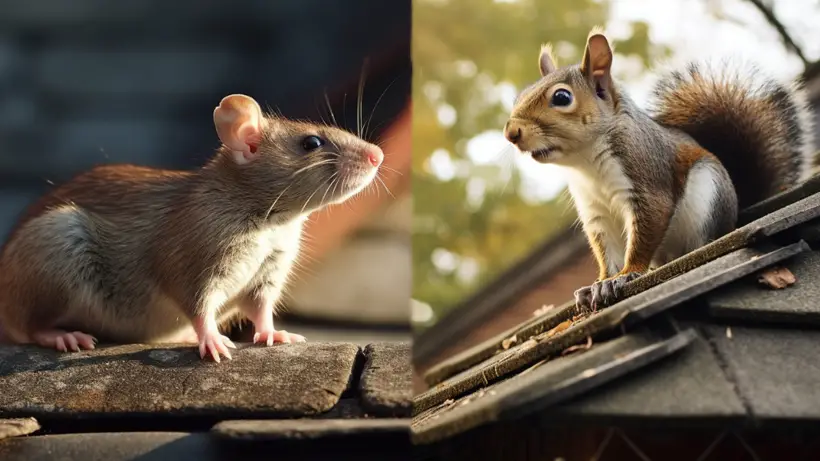Rat Poop vs Squirrel Poop: An In-Depth Comparison
Ever caught a glimpse of a bushy-tailed visitor in your yard? And later on, found some questionable-looking poop deposits? Yes, the poops might be from a squirrel. But these can also be from rats. So, how do you make sure that?
How to differentiate rat poop vs squirrel poop? Well, rat poop is smaller, tapered, hard, dry, dark brown or black in color. Squirrel poop is larger, rounded, soft, moist, light brown, or tan in color. Moreover, if you have found it inside your house, it’s most likely from a rat.
Now, we know you need more precise and in-depth ways to differentiate between these two types of poops. Don’t worry – the guide below will teach you all the distinctive differences in 10 mins. Keep reading!
Rat Poop vs. Squirrel Poop: At-a-glance
Here is a summary of the rat vs squirrel poop comparison for you:
| Feature | Rat Poop | Squirrel Poop |
|---|---|---|
| Size | 1/4 – 1/2 inch long | 3/8 – 1/2 inch long |
| Shape | Tapered, capsule-like | Rounded, bean-like |
| Texture | Hard, dry, smooth | Soft, moist, rough |
| Color | Dark brown or black | Light brown or tan |
| Location | Indoors, in trails and feeding sites | Outdoors, in nests and foraging sites |
| Dietary Traces | Omnivorous – grains, meat, garbage | Herbivorous – nuts, seeds, plant matter |
Rat Poop vs. Squirrel Poop: Differences in Various Aspects
There are several ways to distinguish rat poops from squirrel poops and vice versa. Let’s have a detailed view of those according to the table above.

Poop Size
Rat droppings are usually about 1/4 to 1/2 inch (6 to 12 mm) long and 1/8 to 1/4 inch (3 to 6 mm) wide.
And Squirrel droppings are usually about 3/8 to 1/2 inch (8 to 13 mm) long and 1/8 to 1/4 inch (3 to 6 mm) wide.
Shape of Their Poop
Rat droppings are usually tapered at both ends, giving them a capsule-like appearance. Depending on how they break off from the anus, they may also have pointed or blunt tips. Check out this video for visual clearance.
Conversely, squirrel droppings are usually rounded at both ends, giving them a bean-like appearance. Depending on how they compress in the colon, they may also have flat or concave sides.
The shape of rat and squirrel droppings can also be influenced by their diet and hydration level. As reported in a 2021 study, if rats (or squirrels) eat more fibrous or moist foods, their droppings may be softer and less defined.
Texture Difference
Texture refers to the degree of hardness or softness of feces. It’s also a way to differentiate rat and squirrel poop.
Rat droppings are usually hard and dry. They have a smooth surface and a firm consistency. They may crumble or break when handled or crushed.

On the other hand, squirrel droppings are usually soft and moist. They have a rough surface and a loose consistency. They may stick or smear when handled or crushed.
Poop Color
Rat poop is normally dark brown or black. Depending on the moisture content, it may have a shiny or dull appearance. It may also have a reddish or greenish tint depending on the food intake or health condition.
However, squirrel poop is typically light brown or tan. It may have a glossy or matte appearance, depending on the moisture content. Depending on the food intake or health condition, it may also have a yellowish or bluish tint.
Location Differences
You also have the option to identify rat and squirrel poop on where they are found.
1. Rat Poop
Rat poop can be found in various locations that reflect their habitat preferences and activity patterns. For example, rat poop can be found in:
- Dark, hidden, and protected areas where rats nest and rest., such as attics, basements, cabinets, closets, etc.
- Trails, runways, and burrows where rats travel and explore., such as along walls, pipes, wires, fences, etc.
- Feeding sites where rats scavenge and consume food., such as near garbage cans, compost piles, bird feeders, pet bowls, etc.
2. Squirrels
Squirrels tend to roam widely and forage extensively. You can spot their poop in various types of places. For example, squirrel poop can be found in:
- Nests where squirrels sleep and breed, such as in tree cavities, leaf piles, attics, etc.
- Paths where squirrels travel and explore, such as on branches, roofs, fences, power lines, etc.
- Sites where squirrels store and retrieve food, such as under logs, rocks, soil, snow, etc.
Rat Poop vs. Squirrel Poop: Health Implications for Humans
Let’s also contrast rat and squirrel poop by how they affect human health. Rats and squirrels both cause zoonotic infections in humans.

1. Rat feces
These transmit serious and even fatal zoonotic diseases to humans. These include:
- Leptospirosis: This bacterial infection affects the kidneys, liver, and other organs.
- Hantavirus: Viral infection that affects the lungs and causes respiratory distress.
- Salmonellosis: Bacterial infection, affects the gastrointestinal tract and causes diarrhea, vomiting, and fever.
- Rat-bite fever: Bacterial infections affect the skin and joints and cause inflammation, ulcers, and pain.
2. Squirrel feces
These can also transmit zoonotic diseases to humans, but they are usually less severe and more rare. The diseases include bacterial infections, such as:
- Tularemia: Affects the skin, lymph nodes, and other organs.
- Typhus: Affects the skin, nervous system, and other organs.
- Lyme disease: Affects the skin, joints, and nervous system.
Rat Poop vs. Squirrel Poop: Chemical Composition Differences
Yet another way to compare rat and squirrel poop is by examining their chemical composition.

A. Dietary Traces
Dietary traces are the undigested or partially digested remnants of food that are found in feces.
1. Rat Feces
These contain dietary traces that reflect their omnivorous and opportunistic diet. A 2015 peer-reviewed study suggests that rats can eat almost anything that is edible, including grains, fruits, vegetables, meat, eggs, insects, garbage, etc.
Therefore, rat feces may contain traces of these foods, such as:
- Starch granules
- Plant fibers
- Seed coats
- Insect exoskeletons
- Bone fragments
- Hair strands, etc.
Rat feces may also contain traces of non-food items that rats ingest accidentally or intentionally, such as:
- Plastic
- Metal
- Paper
- Clothes, etc.
2. Squirrel Feces
These contain dietary traces that reflect their herbivorous and selective diet. Squirrels mainly eat plant-based foods, such as nuts, seeds, fruits, buds, flowers, fungi, etc.
Squirrel feces may contain traces of these foods, such as:
- Nutshells
- Seed husks
- Fruit skins
- Fungal spores
- Pollen grains, etc.
Squirrel feces may also contain traces of animal-based foods that squirrels occasionally eat, such as insects, eggs, birds, etc.
B. Metabolites and Hormones
Metabolites are the products of the biochemical reactions that occur in the body.
1. Rat Feces
These contain metabolites and hormones that reflect their high metabolic rate and stress response.

Rats have a fast metabolism that allows them to digest food quickly and efficiently. According to a 2001 research, they contain high levels of metabolites such as:
- Urea nitrogen (BUN)
- Creatinine (Cr)
- Uric acid (UA)
- Glucose (Glu)
- Cholesterol (Chol)
- Triglycerides (TG), etc.
Rat feces may also contain high levels of hormones such as:
- Cortisol (CORT)
- Adrenaline (ADR)
- Noradrenaline (NA)
- Dopamine (DA)
- Serotonin (5-HT), etc.
2. Squirrel Feces
These contain metabolites and hormones that reflect their low metabolic rate and seasonal variation.

Squirrels have a slow metabolism that allows them to conserve energy and survive harsh conditions. So, squirrel feces contain low levels of metabolites such as :
- Urea nitrogen (BUN)
- Creatinine (Cr)
- Uric acid (UA)
- Glucose (Glu)
- Cholesterol (Chol)
- Triglycerides (TG), etc.
Squirrel feces may also contain low levels of hormones such as:
- Cortisol (CORT)
- Adrenaline (ADR)
- Noradrenaline (NA)
- Dopamine (DA)
- Serotonin (5-HT), etc.
FAQs
Some of the most frequently asked questions related to this topic are as follows:
Q1. Are there any differences between male and female rat or squirrel feces?
There are no significant differences between male and female rat or squirrel feces in terms of size, shape, texture, or color. The composition is generally the same.
Q2. How can you tell rat vs squirrel poop apart if they are old or dried out?
Old or dried-out rat poop keeps its elongated capsule shape, while old squirrel poop remains rounded. Rat poop is also more likely to be brittle when dried out.
Q3. Is it possible for rats and squirrels to poop in the same spot in the house?
Yes, rats and squirrels can poop in shared indoor locations if they both find access points into the home, like attics or crawl spaces. Their droppings would intermix.
Final Takeaways
In conclusion, rat and squirrel poop have many differences. Some of the main visual differences between rat and squirrel poop are:
- Rat poop is smaller, tapered, hard, dry, dark brown, or black in color
- Squirrel poop is larger, rounded, soft, moist, light brown or tan in color
- Rat poop is typically found in dark trails and burrows and squirrel poop is found in nests where squirrels sleep and breed
Still confused? Use this video guide to differentiate between rat and squirrel poop.




